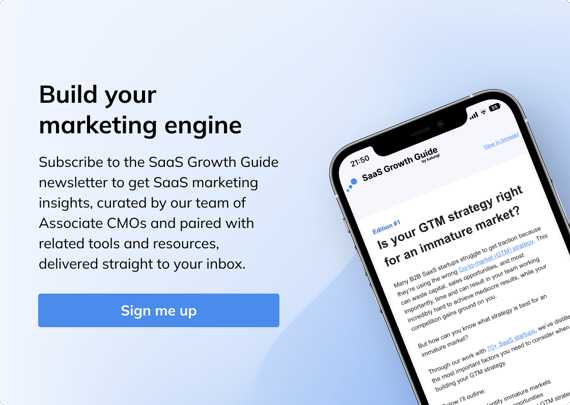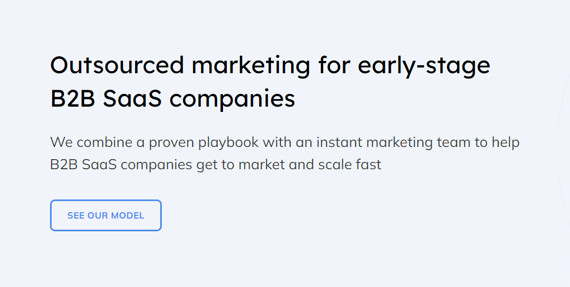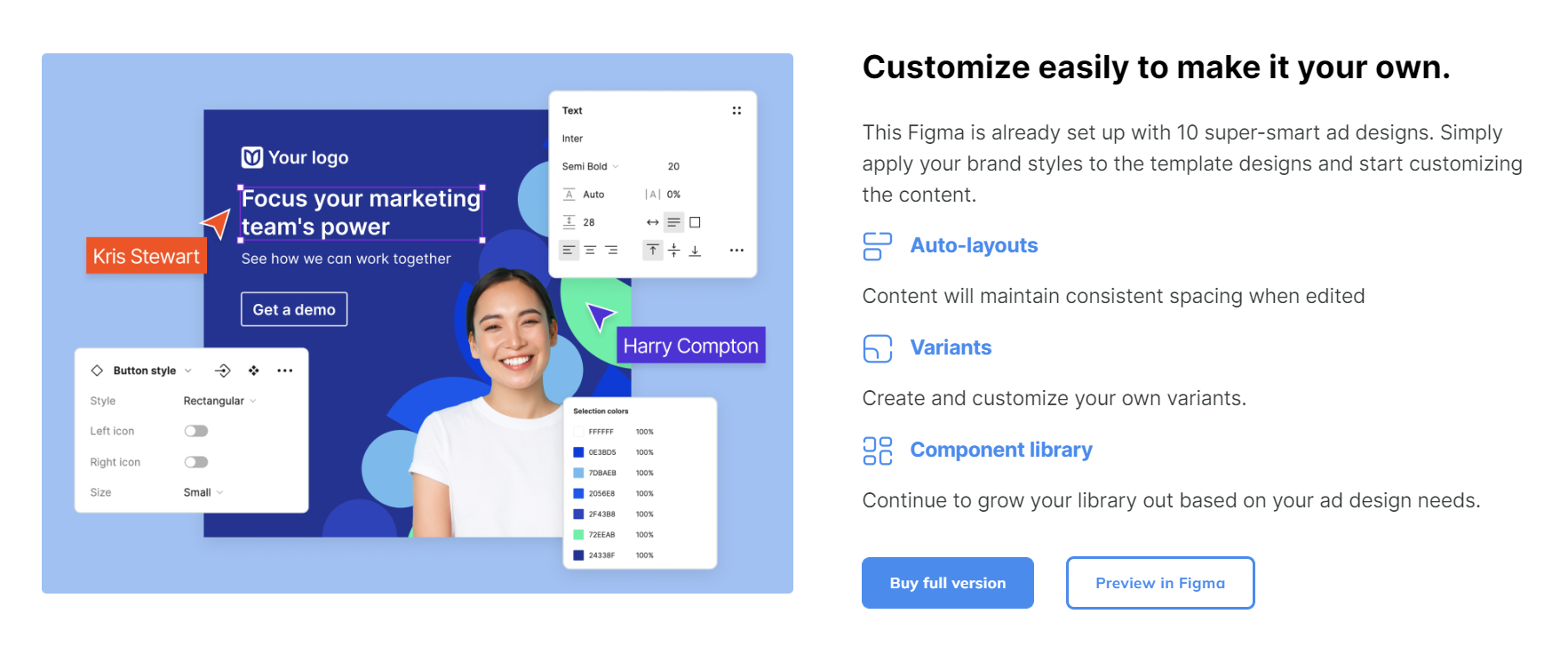B2B conversion rate optimization (CRO) for SaaS companies
Learn about B2B conversion rate optimization( CRO) of your SaaS company website and how keep customers interested and engaged.

It’s estimated that in 2021, the average person is exposed to between 6,000 and 10,000 ads every single day. Whether it’s a subtle product placement within your social media feed or a Google ad appearing in your search results, people typically gloss over them or are completely unaware of them in the first place.
Within the SaaS industry, this can be a major challenge. If money, time, and staff capacity have been spent creating a marketing deliverable, you’re likely hoping to see a return on investment for your work. After all, companies aim to drive prospective customers down the buyer’s journey until they choose to purchase their product or service.
So how do you successfully move both prospects and current customers down the conversion funnel? You develop targeted calls-to-action (CTA) that are so enticing they can’t refuse!
Whether you’ve created a PPC ad, a new landing page, or a relevant blog post, a marketing-orientated CTA is the messaging behind your deliverable that prompts your readers or viewers to take an important action.
Unfortunately, this is not as easy to pull off as it sounds. A CTA should be targeted and informative while remaining concise. When you’re writing a CTA, make the purpose obvious so readers know exactly what the CTA-based action results in.
For instance, if you have a product intended for a highly focused target market, use direct messaging within your CTA so readers will immediately know if they’d benefit from taking the called action. Another great way to reach out to a specific target market is to use the industry language they prefer, which can be easily discovered through SEO research.
We know that CTAs drive customer conversions, but what are the benefits CTAs offer over other marketing conversion tactics? Let’s learn about the other benefits of CTAs to ensure strategy alignment and maximum ROI in the future.
A CTA is often and rightly should be the most visible element of your content. With this added emphasis comes the great possibility of generating a new lead. With this in mind, continue reading to learn about the three main benefits you attain by mastering best-practice CTAs.
You can explicitly state your prospect’s next steps while subliminally letting the customer know what you want them to do. Especially if your customer is new to your brand or product, doing this prevents confusion, ensures they get to learn more about your company if they’re interested, and defines a logical path they can take to successfully use your product.
As an example of a SaaS CTA in action, when reading the Kalungi blog, site visitors will be offered to subscribe to our SaaS Growth Guide newsletter in a pop-up. Since the next logical step for people who have enjoyed the content they found on the Kalungi site would be to register, the CTA prompts them simply to "Sign me up."

On the Kalungi homepage, site visitors are offered to take a less decisive step, that of learning more about Kalungi's services, as opposed to signing up for a meeting directly.

When crafting a CTA, it's important to consider not only what next step you would like for your audience to take but which step they will actually be willing to take at whatever stage of the funnel they are likely to be seeing it.
In some instances, you may wish to provide your audience with two CTAs that provide different next steps so they can choose the one that best fits their buyer's journey stage. Site visitors reading about Kalungi's "Complete B2B SaaS Ad Pack" for Figma are invited to either see the product in action in a demo ("Preview in Figma") or, if they're confident they've found the ads template for them, to skip right to purchasing it ("Buy full version").

You can also generate successful leads through a CTA because, if executed correctly, it will only be clicked when the user is genuinely interested in the next step.
Additionally, CTAs can build buzz and excitement over your company, especially if you’re releasing a new product or starting a new service, and can offer incremental information about it coming up to its release.
Within highly saturated markets and competitive search engine results pages, there’s constant pressure to maintain different forms of content and advertising based on keywords, consumer trends, and marketing timeframes.
A CTA ensures that your newly created content has a purpose and value, both to your company and to the people who come across it. You gain the ability to categorize this content within a defined segment of your customers’ buyer’s journeys and your marketing plan, and in turn, ensure that the results can become measurable and tied to a marketing goal.
Conversions most important to your company can be the endnote of your call to action. These can be simply written, straightforward 1-liners such as “Start Your Free Trial” or “Follow Our Brand’s Facebook Page.” The convenience of these phrases is they can be personalized to improve the marketing metrics that help your business.
New readers who view the page will be drawn to these simple CTAs, which will serve to bring you new prospects and customers. The CTAs may even draw attention to a benefit or aspect of your company that new viewers won’t easily be aware of.
There are many different types of proven CTAs. For a reference of those most effective, we have previously discussed 6 SaaS industry-trusted examples. However, you may be curious as to what the specific success rates look like to reference for your own marketing strategy.
To help you determine when to use a CTA and what metric improvements you can expect, here are some important statistics:
These conversion and revenue increases have had an impact on the whole marketing industry, with many multinational companies leveraging CTAs for their own marketing strategy. You’ve even likely been inclined to complete some of these CTA conversion actions yourself.
For reference on how it’s done right, here are some popular examples of CTAs that have been highly successful in the SaaS industry.
Dropbox is commonly used across many industries to store online files and cloud content. In alignment with their organizational, multi-purpose software, they implement a modern design featuring negative space so as to offer an intuitive online experience.
Their CTA is the perfect example of simple, but effective copy and design: it is a blue button displaying the phrase “Sign up for free.” The button and Dropbox’s logo are designed to be the same color so viewers can tell that the button is referring to starting a main account.
QuickSprout, a company that strategizes SEO and website development to help businesses grow, chose a highly effective CTA that is consistent with what their target audience and buyer personas worry about, which is wasting time implementing ineffective SEO.
Their CTA reads “Are you doing your SEO wrong? Enter your URL to find out.” This message catches the attention of the viewer and provides a tangible benefit from performing the action asked.
Additionally, QuickSprout often places their CTAs within the middle of their blogs, as opposed to the end of them, which further raises the chances their viewers will spot it (and use it as a resource) before they may choose to leave the website. This method of placing a CTA is corroborated by how readers typically only read the first 60% of a piece of content.
Because CTAs need to be concise, starting them with the desired action or a powerful verb helps get the ball rolling and sounds more enthusiastic. For instance, if your CTA was “Our most recent software feature is available and can be made a great resource for you,” you may not get many conversions as it’s a longer statement that doesn’t explain the action customers can take. Instead, writing something like “Download our commodity intelligence software today!” within a highlighted button may improve your click-through rate (CTR).
Using active wording also immediately improves the level of enthusiasm showcased within the messaging of your CTA. As an easy tip, simply using an exclamation point at the end of a CTA can increase the elicited enthusiasm and make it more noticeable.
Always make sure that your CTAs are more focused on providing benefits to your customers, as opposed to solely promoting something from your company. To determine what benefit your service or product should be catering to within your CTAs, determine what your prospects and current customers are looking for or hoping to solve.
Your unique selling point is an essential part of your business; it helps you stand out within your industry and among your competitors. Maybe you have a very distinct USP, such as a software service that no other company can offer, or perhaps you’re within a more competitive market, and your USP is hands-on customer service or a streamlined way of doing the usual task.
No matter what it is, integrating your USP’s value within your CTA is a highly effective way to generate more conversions. A great example of this could be “Click Here To Calculate Your ROI” because it states the desired conversion action (clicking the CTA button) while letting customers know one of your USPs (an ROI calculator for your services).
Not to mention, describing your USP is a great way to make your prospective customers feel like they are missing out on a life-saving service or feature, which leads to our next tip...
FOMO stands for fear of missing out and is possibly one of the most effective tactics of marketing. Just look at the amount of scarcity marketing that occurs within B2C industries as companies purposefully release small batches of new products so they sell out quickly. Companies do this for one reason: to generate panic and faster action among their customers.
Now, we’re actually not recommending you do this, because you shouldn’t have to. But if your product provides an incredible opportunity for your consumers, one they will not get by relying on an outdated product or service or choosing one of your competitors, make sure they know of it!
So how do you write your CTAs to generate FOMO? Simply make sure to promote never-before-seen features or temporary sales and promotions that won’t last long. You’ve seen these CTAs yourself: “30% Of Purchases Of $150+ Until December 1st,” or “Order Today To Get It By December 25th.”
These often time-sensitive or product-specific CTAs work like a charm when you have a campaign or product on the rise, with lots of accompanying marketing goals to meet. You will definitely reap the benefits of some extra clicks!
As consumers, we are often heavily influenced by pricing, discounts, and incentives. And having all of these numbers upfront can be the single most important factor in purchasing a product or service.
One way to make these figures obvious, especially if one of your company’s benefits is great pricing, is to mention pricing in your CTA. A benefit of doing this is you’ll receive leads who are still interested in your product or service while knowing how much it costs, which increases your chances of getting even more conversions.
Gain more leads, drive prospects down the buyer’s journey, and establish yourself as a competitive lead in the SaaS industry by nailing your CTAs.
To learn more about generating leads, check out our blog on 6 content promotion strategies for B2B SaaS CMOs.
Learn about B2B conversion rate optimization( CRO) of your SaaS company website and how keep customers interested and engaged.
Learn the importance of reviews and referrals for your B2B SaaS Marketing strategy, and how it can impact revenue and boost conversion rates.
Download the SaaS funnel stage template. What are good conversion rates and benchmarks for the stages of the B2B SaaS sales and marketing funnel?
Be the first to know about new B2B SaaS Marketing insights to build or refine your marketing function with the tools and knowledge of today’s industry.